ABOUT THE MIAMI BEACH BOTANICAL GARDEN
About
Annual Report
History
In 1962 the City of Miami Beach created the “Garden Center” on a vacant site opposite the Miami Beach Convention Center that was built in 1957. Operated then as a City park, the Garden was situated on the historic Collins Canal, an integral part of the beginnings of Miami Beach. In the early 1900s pioneer John Collins dug the canal to transport mangos and avocados (called alligator pears) by boat to the Port of Miami from groves along what is now Pinetree Drive.
In the 1920s pioneer Carl Fisher developed Lincoln Road, luxury hotels such as the Flamingo and the Nautilus with polo fields and golf courses. The Garden site was originally a golf course. Fisher promoted tourism with the help of a baby elephant named Rosie who in 1921 served as golf caddy to vacationing President-elect Warren Harding.
By 1922 Miami Beach boasted the largest avocado and mango groves in the world, but Miami’s agricultural roots wouldn’t last much longer, sacrificed for the tourist trade. Tourism has long been a driving force in Miami Beach, but the City also experienced the impact of economic recessions, World Wars, and destructive hurricanes. The Garden had sadly deteriorated before the Art Deco renaissance of the 1980s and after Hurricane Andrew in 1992.
A group of residents approached the City in 1996 to create the Miami Beach Garden Conservancy as a non-profit organization with a mission to restore the Garden. Today’s Miami Beach Botanical Garden is a public/private partnership, owned by the City of Miami Beach and operated by the Conservancy. The Garden has again become a dynamic venue for arts and cultural programming, environmental education and cultural tourism.

